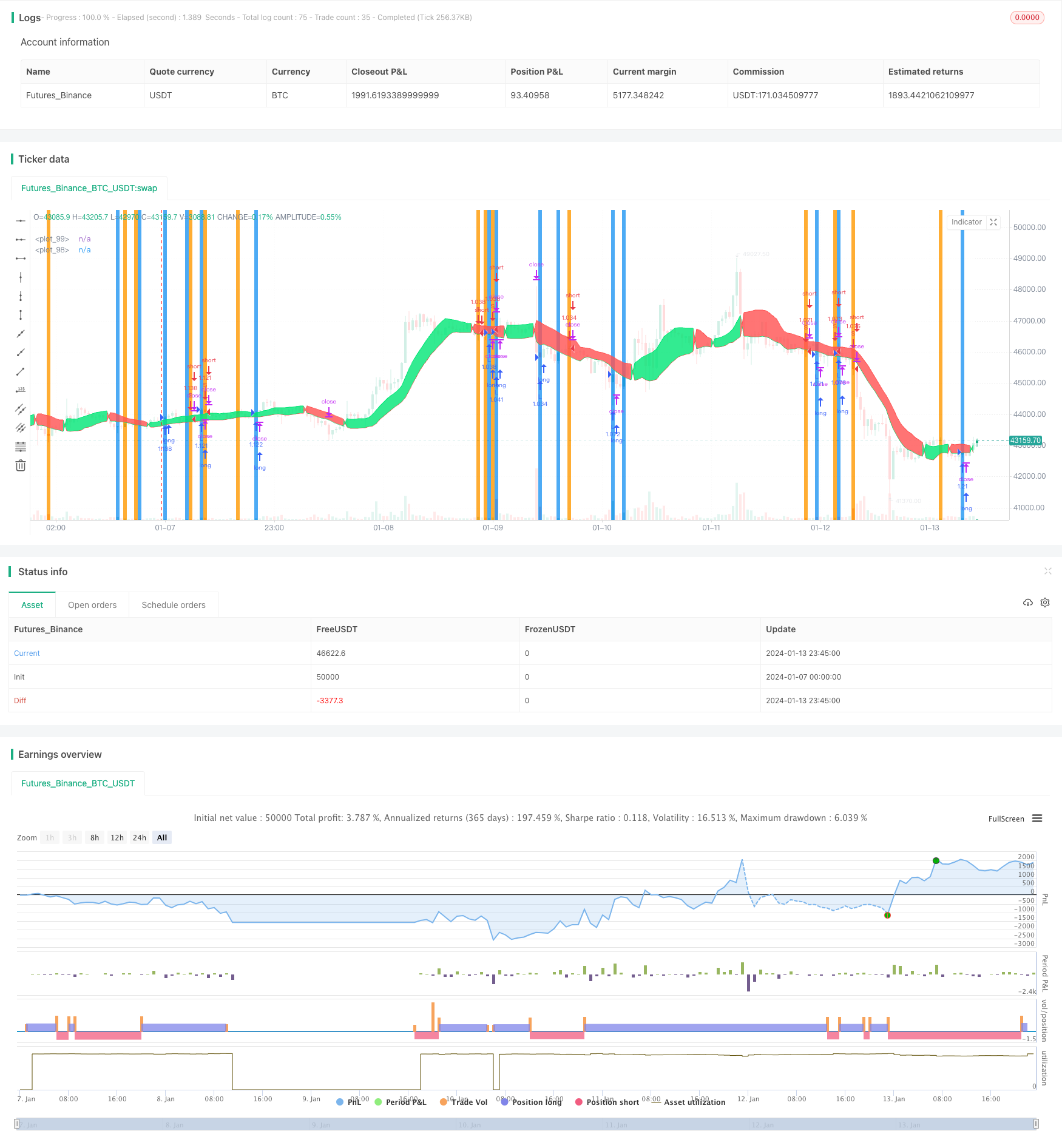
概述
该策略综合应用了螺旋通道指标和差速率指标,当价格突破上轨线和均线时产生买入信号。同理,当价格突破下轨线和均线时,产生卖出信号。该策略通过螺旋通道来判断价格的趋势方向,并利用差速率指标来检测价格动能,在两个指标同时确认的基础上产生交易信号,从而取得较好的胜率。
策略原理
该策略主要基于两个指标:
螺旋通道(Spiral Channels):计算上下轨线,用来判断价格的趋势方向。当价格突破上轨时看涨,突破下轨时看跌。
差速率指标(ROC):检测价格是否在加速,用来判断价格动能。 ROC大于某个正值时表示价格在上涨加速,小于某个负值时表示价格在下跌加速。
在螺旋通道和差速率指标同时发出多头信号时产生买入信号。也就是价格要同时突破上轨和显示出上涨加速的迹象。产生卖出信号的逻辑也是类似的。
这样的组合可以提高信号的可靠性,避免在没有明确趋势的情况下盲目交易。
策略优势
综合判断价格趋势和动能,信号较为可靠,胜率较高。
通过参数优化,可以调整策略的交易频率。如调整差速率指标的参数,从而控制开仓的敏感度。
采用停损来控制单笔亏损。参数可自定义设置。
重新入场机制可以追踪趋势,进一步提升盈利能力。
策略风险
会漏掉部分交易机会,盈利能力受到一定限制。
突破型策略容易被套牢。当价格反转时,可能带来较大的亏损。
参数设置不当可能导致交易信号过于频繁或稀疏。
固定百分比的止损无法完全避免较大的单笔亏损的发生。
策略优化方向
对差速率指标的参数进行测试,找到最佳参数组合。
测试不同的止损水平,平衡盈亏比和胜率。
添加其他指标过滤,如量能指标、震荡指标等,提高信号质量。
测试不同的市场,寻找最匹配该策略的品种。
优化策略的仓位管理,不同市况下采用不同的仓位。
总结
该策略综合运用螺旋通道和差速率指标判断价格的趋势和动能,在确保交易信号质量的同时,通过重新入场以及参数优化来维持盈利的能力。风险控制以固定百分比的止损为主,可以做进一步优化。总的来说,该策略较完整,适合作为量化交易的基础框架。
/*backtest
start: 2024-01-07 00:00:00
end: 2024-01-14 00:00:00
period: 45m
basePeriod: 5m
exchanges: [{"eid":"Futures_Binance","currency":"BTC_USDT"}]
*/
//@version=4
strategy("SSL Chaikin BF 🚀", overlay=true, precision=2, initial_capital=10000, default_qty_type=strategy.percent_of_equity, default_qty_value=100, commission_type=strategy.commission.percent, commission_value=0.075)
/////////////// Time Frame ///////////////
_0 = input(false, "════════ Test Period ═══════")
testStartYear = input(2017, "Backtest Start Year")
testStartMonth = input(1, "Backtest Start Month")
testStartDay = input(1, "Backtest Start Day")
testPeriodStart = timestamp(testStartYear,testStartMonth,testStartDay, 0, 0)
testStopYear = input(2019, "Backtest Stop Year")
testStopMonth = input(12, "Backtest Stop Month")
testStopDay = input(31, "Backtest Stop Day")
testPeriodStop = timestamp(testStopYear,testStopMonth,testStopDay, 0, 0)
testPeriod() => true
/////////////// Chaikin MF ///////////////
_1 = input(false, "═══════ Chaikin MF ═══════")
length = input(20, minval=1, title = "Chaikin SMA Length")
upperThreshold = input(0.04, step=0.01, title="Upper Threshold")
lowerThreshold = input(0.02, step=0.01, title="Lower Threshold")
ad = close==high and close==low or high==low ? 0 : ((2*close-low-high)/(high-low))*volume
mf = sum(ad, length) / sum(volume, length)
/////////////// SSL Channels ///////////////
_2 = input(false, "═════════ SSL ══════════")
len1=input(title="SMA Length 1", defval=12)
len2=input(title="SMA Length 2", defval=13)
smaHigh = sma(high, len1)
smaLow = sma(low, len2)
Hlv = 0
Hlv := close > smaHigh ? 1 : close < smaLow ? -1 : Hlv[1]
sslDown = Hlv < 0 ? smaHigh : smaLow
sslUp = Hlv < 0 ? smaLow : smaHigh
///////////// Rate Of Change /////////////
_3 = input(false, "══════ Rate of Change ══════")
source = close
roclength = input(13, "ROC Length", minval=1)
pcntChange = input(4, "ROC % Change", minval=1)
roc = 100 * (source - source[roclength]) / source[roclength]
emaroc = ema(roc, roclength / 2)
isMoving() => emaroc > (pcntChange / 2) or emaroc < (0 - (pcntChange / 2))
/////////////// Strategy ///////////////
long = sslUp > sslDown and isMoving() or crossover(mf, upperThreshold)
short = sslUp < sslDown and isMoving() or crossunder(mf, lowerThreshold)
last_long = 0.0
last_short = 0.0
last_long := long ? time : nz(last_long[1])
last_short := short ? time : nz(last_short[1])
long_signal = crossover(last_long, last_short)
short_signal = crossover(last_short, last_long)
last_open_long_signal = 0.0
last_open_short_signal = 0.0
last_open_long_signal := long_signal ? open : nz(last_open_long_signal[1])
last_open_short_signal := short_signal ? open : nz(last_open_short_signal[1])
last_long_signal = 0.0
last_short_signal = 0.0
last_long_signal := long_signal ? time : nz(last_long_signal[1])
last_short_signal := short_signal ? time : nz(last_short_signal[1])
in_long_signal = last_long_signal > last_short_signal
in_short_signal = last_short_signal > last_long_signal
last_high = 0.0
last_low = 0.0
last_high := not in_long_signal ? na : in_long_signal and (na(last_high[1]) or high > nz(last_high[1])) ? high : nz(last_high[1])
last_low := not in_short_signal ? na : in_short_signal and (na(last_low[1]) or low < nz(last_low[1])) ? low : nz(last_low[1])
since_longEntry = barssince(last_open_long_signal != last_open_long_signal[1])
since_shortEntry = barssince(last_open_short_signal != last_open_short_signal[1])
//////////////// Stop loss ///////////////
_4 = input(false, "════════ Stop Loss ═══════")
sl_inp = input(2.0, title='Stop Loss %') / 100
slLong = in_long_signal ? strategy.position_avg_price * (1 - sl_inp) : na
slShort = strategy.position_avg_price * (1 + sl_inp)
long_sl = in_long_signal ? slLong : na
short_sl = in_short_signal ? slShort : na
/////////////// Execution ///////////////
if testPeriod()
strategy.entry("L", strategy.long, when=long)
strategy.entry("S", strategy.short, when=short)
strategy.exit("L SL", "L", stop=long_sl, when=since_longEntry > 0)
strategy.exit("S SL", "S", stop=short_sl, when=since_shortEntry > 0)
/////////////// Plotting ///////////////
p1 = plot(sslDown, linewidth = 1, color=color.red)
p2 = plot(sslUp, linewidth = 1, color=color.lime)
fill(p1, p2, color = sslDown < sslUp ? color.lime : color.red, transp=80)
bgcolor(isMoving() ? long ? color.green : short ? color.red : na : color.white, transp=80)
bgcolor(long_signal ? color.lime : short_signal ? color.red : na, transp=30)
bgcolor(crossover(mf, upperThreshold) ? color.blue : crossunder(mf, lowerThreshold) ? color.orange : na, transp=30)